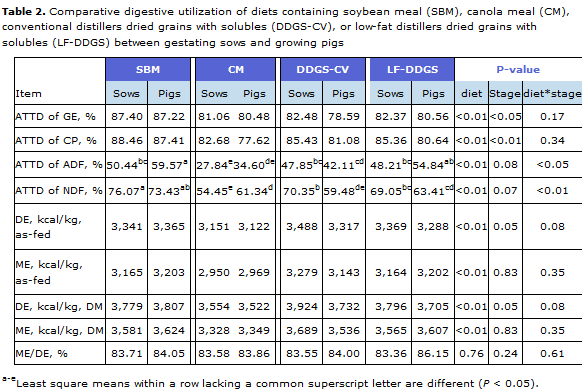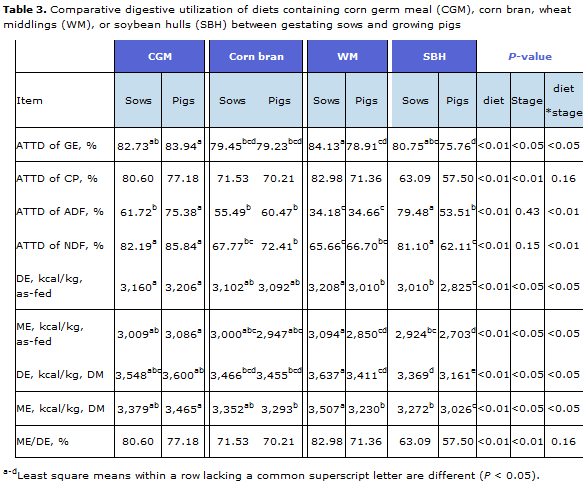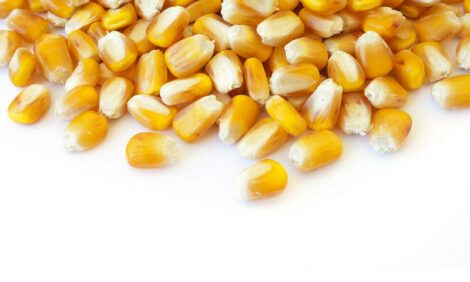



Comparative Digestibility of Energy and Nutrients in Diets Fed to Sows and Growing Pigs
The apparent digestibility of fibre by pregnant sows was not different from values obtained in growing pigs for most of the feed ingredients tested in this study from the Hans H. Stein Monogastric Nutrition Laboratory at the University of Illinois. Energy and protein digestibilities were higher for sows than growing pigs.Results of experiments in Europe have indicated that the apparent total tract digestibility (ATTD) of gross energy and nutrients, as well as the concentration of digestible (DE) and metabolisable (ME) energy, is greater in gestating sows fed close to their maintenance requirement than in growing pigs allowed ad libitum access to feed.
However, no data from North America for the comparative digestibility of energy and nutrients in sows and growing pigs have been reported. Therefore, an experiment was conducted to compare the digestibility of energy and nutrients in sows and growing pigs. A second objective was to develop equations to predict digestibility of energy and nutrients in sows from digestibility values obtained in growing pigs.
Experimental Design
A total of 88 gestating sows (parity 2 to 6) as well as 88 growing barrows with an average initial body weight of 40.1kg were used in the experiment.
Eleven diets were formulated. The three cereal grain-diets were based on corn, sorghum and wheat. The remaining eight diets were based on a combination of corn and one of eight ingredients. Four of the ingredients were common sources of plant protein: soybean meal, canola meal, conventional distillers dried grains with solubles (DDGS-CV), and low-fat DDGS (LF-DDGS). Four other ingredients were commonly used high-fibre ingredients: corn germ meal, corn bran, wheat middlings and soybean hulls.
Sows and growing pigs were fed the same diets. Feed was provided in two equal meals per day for a total of 1.5 and 3.4 times the estimated energy requirement for maintenance in gestating sows and growing pigs, respectively.
Faecal and urine samples were collected and analysed to calculate the ATTD of gross energy (GE), crude protein (CP), acid detergent fibre (ADF), and neutral detergent fibre (NDF) and the concentrations of DE and ME in each diet.
Energy and crude protein digestibility were greater in sows than in growing pigs
For all of the grain diets, the ATTD of GE and CP, and the concentrations of DE and ME, were greater (P<0.05) for gestating sows than for growing pigs (Table 1). There was also a tendency for the ME:DE ratio to be greater in gestating sows than in growing pigs.

For the diets containing protein ingredients, the ATTD of GE and CP and the concentration of DE was greater (P<0.05) for sows than for pigs (Table 2). There was no difference in ME or in the ME:DE ratio between sows and pigs.

For the high-fibre diets, the ATTD of CP and the ME:DE ratio were greater (P<0.05) for sows than for pigs (Table 3). The ATTD of GE was greater (P<0.05) for sows fed the wheat middlings diet or the soybean hulls diet than for pigs but there was no difference between sows and pigs fed the corn germ meal diet or the corn bran diet.
The concentrations of DE and ME for the wheat middlings diet and the soybean hulls diet were greater (P<0.05) for sows than for pigs, but there was no difference in DE and ME values between sows and pigs fed the corn germ meal diet or the corn bran diet.

Mixed results for fibre digestibility
The ATTD of ADF was greater (P<0.05) for growing pigs fed the wheat, soybean meal or corn germ meal diets than for gestating sows. The ATTD of NDF was greater (P<0.05) for growing pigs fed wheat or canola meal than for gestating sows.
The ATTD of ADF was greater (P<0.05) for sows fed soybean hulls than for pigs. The ATTD of NDF was greater (P<0.05) for sows fed corn, DDGS-CV and soybean hulls than for pigs.
No difference was observed between sows and pigs in the ATTD of ADF in corn, sorghum, canola meal, DDGS-CV, LF-DDGS, corn bran or wheat middlings.
There was no difference in the ATTD of NDF between sows and pigs fed sorghum, soybean meal, LF-DDGS, corn germ meal, corn bran or wheat middlings.
Results of previous research indicated that sows are able to utilise fibre more efficiently than growing pigs because their greater intestinal volume allows for more fermentation of fibre. This experiment did not confirm that difference. One possible reason is that both sows and pigs were allowed to adapt to their diets for 20 days before faecal collection began. The adaptation period may have allowed the growing pigs to adapt to the fibre by increasing hind-gut size and thus fermentation.
Predicting digestibility in sows from values obtained in growing pigs
The ATTD of GE and CP, and the DE values for gestating sows could be predicted from the values obtained in growing pigs by using the following equations:
ATTD of GE, % 22.7553 + 0.7506*ATTDGEpig R2 = 0.78
ATTD of CP, % 27.2137 + 0.7232*ATTDCPpig R2 =0.72
DE, kcal/kg DM 911.57 + 0.7727*DEpig R2 = 0.78
Prediction equations were developed for ATTD of ADF, NDF, and ME values for gestating sows as well; however, the R2 values for these equations were 0.55, 0.36 and 0.54 respectively.
Key Points
- The apparent digestibility of gross energy and crude protein, as well as concentrations of digestible and metabolisable energy observed in gestating sows were greater than values observed in growing pigs.
- The apparent digestibility of fibre obtained in gestating sows was not different from values obtained in growing pigs for most ingredients.
- The ATTD of GE and CP, and DE values in gestating sows may be predicted from the values obtained in growing pigs.
This report is based on research conducted by Jessica Lowell and Hans Stein and published in Jessica Lowell's master's thesis.
July 2014








